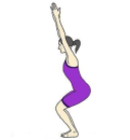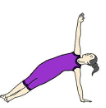 |
The Quadratus Lumborum (QL) muscle is located in the deep and posterior, lateral and inferior areas of the spine. It is the deepest muscle of the posterior abdominal wall. The muscle is flattened and has a quadrangular shape. |
The QL plays an essential role in the posture and helps stabilize the spine when extending the lower back or bending to the side. It also supports the core of the body when breathing.
- Key factors on the QL muscles
- Location: Between the top of the pelvis and the lowest rib
- Origin: Medial crest
- Insertion: Lower rib 12 and transverse process of lumbar vertebrae L1 to L4
- Antagonists: Abdominals
- Synergists: each other, latissimus dorsi, trapezius
- What are the main causes of QL pain?
The QL is one of the primary sources of lower back pain. Pain can be due to overuse, stress and strain. The most common examples are:
- Sitting for long hours implies continuous contraction or tightening of the QL and can therefore lead to muscle fatigue. If blood flow is decreased, the muscle can become stiff and painful.
- Poor posture when sitting or standing
- Weak surrounding muscles. When other muscles in the back or the pelvic area are weak, the QL has to compensate and work harder to support the body. It will eventually become overworked and tense
- Unequal leg length
- Trauma
- Incorrect or awkward lifting of objects
- How can QL pain be treated?
In some cases, depending on the severity of the pain, YOGA practise is highly recommended alone or in combination with medical treatment. Below are some recommendations:
- Strengthening poses
 |
Utkatasana:
QL engaged with the other back and core muscles to maintain length in upper body |
 |
Vashistasana:
QL engaged to stabilise the torso and not collapse or rotate |
 |
Santolasana:
QL engaged to stabilise the posture and offer back strength and length |
 |
Shalabhasana:
QL engaged to extend back, especially when coming up from prone position |
- Stretching poses
 |
Tiryaka tadasana:
Lateral flexion with QL, gentle stretch |
 |
Balasana:
Extension of spine using QL, gentle stretch |
 |
Utthitha trikonasana:
Extension of spine + lateral flexion of spine using QL, gentle stretch |
 |
Kurmasana:
Extension of spine using QL, deep stretch |
In any cases, staying healthy and aware of the sources of the pain will lead to improvement.
E.g., good standing and sitting postures, lifting heavy objects properly, sleeping in a proper position.
- STRETCHING POSES
|
|||||||
|
|||||||
In any cases, staying healthy and aware of the sources of the pain will lead to improvement.
E.g., good standing and sitting postures, lifting heavy objects properly, sleeping in a proper position.

